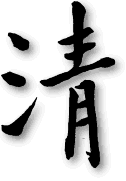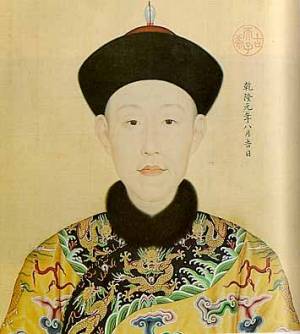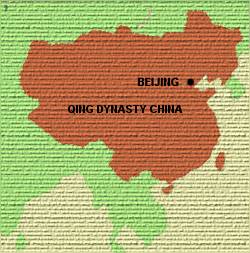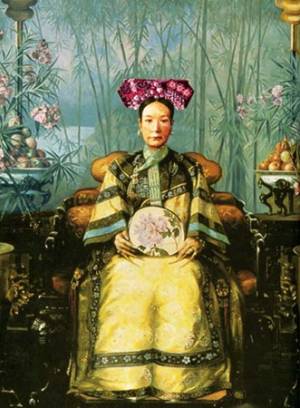


QING1644-1911
Kangxi 1662-1722 Yongzheng 1723-35 Qianlong 1736-95 Jiaqing 1796-1820 Daoguang 1821-50 Xianfeng 1851-61 Tongzhi 1862-74 Guangxu 1875-1908 Xuantong 1909-11 |

|
The Manchus to the north had long been growing in power. Taking advantage of the turmoil in China, they launched an invasion that initially was held back by the Great Wall. Eventually, they were allowed to pass by a Ming general, who saw an alliance with the Manchus as his only hope for defeating the peasant rebels threatening Beijing. The Manchus quickly defeated the peasant forces. In June 1644, they marched into the Ming capital and made it their own.
It would be about 40 years before they would clear the south of Ming loyalist forces and pacify the entire country. Today's Chinese "triads" are the descendants of secret societies originally set up to resist the Manchus.
Although the Manchus were not Han Chinese they had assimilated a great deal of Chinese culture before conquering China Proper. Realizing that to dominate the empire they would have to do things the Chinese way, the Manchus retained many institutions of Ming and earlier Chinese derivation. They continued the Confucian court practices and temple rituals, over which the emperors had traditionally presided.

|
| Inaugural portrait of the Qianlong emperor, (dated 1736) by the Jesuit missionary Castiglione / Lang Shining; (1688-1766). Handscroll, ink and color on silk, now at Cleveland Museum. |
Ever suspicious of Han Chinese, the Qing rulers put into effect measures aimed at preventing the absorption of the Manchus into the dominant Han Chinese population. Han Chinese were prohibited from migrating into the Manchu homeland, and Manchus were forbidden to engage in trade or manual labor. Intermarriage between the two groups was forbidden. In many government positions a system of dual appointments was used - the Chinese appointee was required to do the substantive work and the Manchu to ensure Han loyalty to Qing rule.
The Qing regime was determined to protect itself not only from internal rebellion but also from foreign invasion. After China Proper had been subdued, the Manchus conquered Outer Mongolia (now the Mongolian People's Republic) in the late seventeenth century. In the eighteenth century they gained control of Central Asia as far as the Pamir Mountains and established a protectorate over the area the Chinese call Xizang but commonly known in the West as Tibet. The Qing thus became the first dynasty to eliminate successfully all danger to China Proper from across its land borders.

|
| Under Manchu rule the empire grew to include a larger area than before or since |
The chief threat to China's integrity did not come overland, as it had so often in the past, but by sea, reaching the southern coastal area first. Western traders, missionaries, and soldiers of fortune began to arrive in large numbers even before the Qing, in the sixteenth century. The empire's inability to evaluate correctly the nature of the new challenge or to respond flexibly to it resulted in the demise of the Qing and the collapse of the entire millennia-old framework of dynastic rule.
The success of the Qing dynasty in maintaining the old order proved a liability when the empire was confronted with growing challenges from seafaring Western powers. The centuries of peace and self-satisfaction dating back to Ming times had encouraged little change in the attitudes of the ruling elite.
The imperial Neo-Confucian scholars accepted as axiomatic the cultural superiority of Chinese civilization and the position of the empire at the hub of their perceived world. To question this assumption, to suggest innovation, or to promote the adoption of foreign ideas was viewed as tantamount to heresy. Imperial purges dealt severely with those who deviated from orthodoxy.
By the nineteenth century, China was experiencing growing internal pressures of economic origin. By the start of the century, there were over 300 million Chinese, but there was no industry or trade of sufficient scope to absorb the surplus labor. Moreover, the scarcity of land led to widespread rural discontent and a breakdown in law and order. The weakening through corruption of the bureaucratic and military systems and mounting urban pauperism also contributed to these disturbances.
Localized revolts erupted in various parts of the empire in the early nineteenth century. Secret societies, such as the White Lotus sect in the north and the Triad Society in the south, gained ground, combining anti-Manchu subversion with banditry.
The Western Powers Arrive
As elsewhere in Asia, in China the Portuguese had been the pioneers having established a foothold at Macao (Aomen in pinyin) from which they monopolized foreign trade at the Chinese port of Guangzhou (Canton). Soon the Spanish arrived, followed by the British and the French.
Trade between China and the West was carried on in the guise of tribute: foreigners were obliged to follow the elaborate, centuries-old ritual imposed on envoys from China's tributary states. There was no conception at the imperial court that the Europeans would expect or deserve to be treated as cultural or political equals. The sole exception was Russia, the most powerful inland neighbor.
The Manchus were sensitive to the need for security along the northern land frontier and therefore were prepared to be realistic in dealing with Russia. The Treaty of Nerchinsk (1689) with the Russians, drafted to bring to an end a series of border incidents and to establish a border between Siberia and Manchuria (northeast China) along the Heilong Jiang (Amur River), was China's first bilateral agreement with a European power. In 1727 the Treaty of Kiakhta delimited the remainder of the eastern portion of the Sino-Russian border.
Western diplomatic efforts to expand trade on equal terms were rebuffed, the official Chinese assumption being that the empire was not in need of foreign - and thus inferior - products. Despite this attitude, trade flourished, even though after 1760 all foreign trade was confined to Guangzhou, where the foreign traders had to limit their dealings to a dozen officially licensed Chinese merchant firms.
Trade was not the sole basis of contact with the West. Since the thirteenth century, Roman Catholic missionaries had been attempting to establish their church in China. Although by 1800 only a few hundred thousand Chinese had been converted, the missionaries - mostly Jesuits contributed greatly to Chinese knowledge in such fields as cannon casting, calendar making, geography, mathematics, cartography, music, art, and architecture. The Jesuits were especially adept at fitting Christianity into a Chinese framework and were condemned by a papal decision in 1704 for having tolerated the continuance of Confucian ancestor rites among Christian converts.
The papal decision quickly weakened the Christian movement, which it proscribed as heterodox and disloyal.
The Opium War, 1839-42
During the eighteenth century, the market in Europe and America for tea, a new drink in the West, expanded greatly. Additionally, there was a continuing demand for Chinese silk and porcelain. But China, still in its preindustrial stage, wanted little that the West had to offer, causing the Westerners, mostly British, to incur an unfavorable balance of trade. To remedy the situation, the foreigners developed a third-party trade, exchanging their merchandise in India and Southeast Asia for raw materials and semiprocessed goods, which found a ready market in Guangzhou. By the early nineteenth century, raw cotton and opium from India had become the staple British imports into China, in spite of the fact that opium was prohibited entry by imperial decree. The opium traffic was made possible through the connivance of profit-seeking merchants and a corrupt bureaucracy.
In 1839 the Qing government, after a decade of unsuccessful anti-opium campaigns, adopted drastic prohibitory laws against the opium trade. The emperor dispatched a commissioner, Lin Zexu (1785-1850), to Guangzhou to suppress illicit opium traffic. Lin seized illegal stocks of opium owned by Chinese dealers and then detained the entire foreign community and confiscated and destroyed some 20,000 chests of illicit British opium. The British retaliated with a punitive expedition, thus initiating the first Anglo-Chinese war, better known as the Opium War (1839-42). Unprepared for war and grossly underestimating the capabilities of the enemy, the Chinese were disastrously defeated, and their image of their own imperial power was tarnished beyond repair. The Treaty of Nanjing (1842), signed on board a British warship by two Manchu imperial commissioners and the British plenipotentiary, was the first of a series of agreements with the Western trading nations later called by the Chinese the "unequal treaties."
Under the Treaty of Nanjing, China ceded the island of Hong Kong (Xianggang in pinyin) to the British; abolished the licensed monopoly system of trade; opened 5 ports to British residence and foreign trade; limited the tariff on trade to 5 percent ad valorem; granted British nationals extraterritoriality (exemption from Chinese laws); and paid a large indemnity. In addition, Britain was to have most-favored-nation treatment, that is, it would receive whatever trading concessions the Chinese granted other powers then or later. The Treaty of Nanjing set the scope and character of an unequal relationship for the ensuing century of what the Chinese would call "national humiliations." The treaty was followed by other incursions, wars, and treaties that granted new concessions and added new privileges for the foreigners.
The Taiping Rebellion, 1851-64
During the mid-nineteenth century, China's problems were compounded by natural calamities of unprecedented proportions, including droughts, famines, and floods. Government neglect of public works was in part responsible for this and other disasters, and the Qing administration did little to relieve the widespread misery caused by them. Economic tensions, military defeats at Western hands, and anti-Manchu sentiments all combined to produce widespread unrest, especially in the south. South China had been the last area to yield to the Qing conquerors and the first to be exposed to Western influence. It provided a likely setting for the largest uprising in modern Chinese history - the Taiping Rebellion.
The Taiping rebels were led by Hong Xiuquan (1814-64), a village teacher and unsuccessful imperial examination candidate. Hong formulated an eclectic ideology combining the ideals of pre-Confucian utopianism with Protestant beliefs. He soon had a following in the thousands who were heavily anti-Manchu and anti-establishment. Hong's followers formed a military organization to protect against bandits and recruited troops not only among believers but also from among other armed peasant groups and secret societies. In 1851 Hong Xiuquan and others launched an uprising in Guizhou Province. Hong proclaimed the Heavenly Kingdom of Great Peace (Taiping Tianguo, or Taiping for short) with himself as king. The new order was to reconstitute a legendary ancient state in which the peasantry owned and tilled the land in common; slavery, concubinage, arranged marriage, opium smoking, footbinding, judicial torture, and the worship of idols were all to be eliminated.
The Taiping tolerance of the esoteric rituals and quasi-religious societies of south China - themselves a threat to Qing stability - and their relentless attacks on Confucianism - still widely accepted as the moral foundation of Chinese behavior - contributed to the ultimate defeat of the rebellion. Its advocacy of radical social reforms alienated the Han Chinese scholar-gentry class. The Taiping army, although it had captured Nanjing and driven as far north as Tianjin, failed to establish stable base areas. The movement's leaders found themselves in a net of internal feuds, defections, and corruption. Additionally, British and French forces, being more willing to deal with the weak Qing administration than contend with the uncertainties of a Taiping regime, came to the assistance of the imperial army. Before the Chinese army succeeded in crushing the revolt, however, 14 years had passed, and well over 30 million people were reported killed.
To defeat the rebellion, the Qing court needed, besides Western help, an army stronger and more popular than the demoralized imperial forces. In 1860, scholar-official Zeng Guofan (1811-72), from Hunan Province, was appointed imperial commissioner and governor-general of the Taiping-controlled territories and placed in command of the war against the rebels. Zeng's Hunan army, created and paid for by local taxes, became a powerful new fighting force under the command of eminent scholar-generals. Zeng's success gave new power to an emerging Han Chinese elite and eroded Qing authority. Simultaneous uprisings in north China (the Nian Rebellion) and southwest China (the Muslim Rebellion) further demonstrated Qing weakness.
The Self-Strengthening Movement
The rude realities of the Opium War, the unequal treaties, and the mid-century mass uprisings caused Qing courtiers and officials to recognize the need to strengthen China. Chinese scholars and officials had been examining and translating "Western learning" since the 1840s. Under the direction of modern-thinking Han officials, Western science and languages were studied, special schools were opened in the larger cities, and arsenals, factories, and shipyards were established according to Western models. Western diplomatic practices were adopted by the Qing, and students were sent abroad by the government and on individual or community initiative in the hope that national regeneration could be achieved through the application of Western practical methods.

|
| Empress Dowager Cixi (1835-1908) |
The effort to graft Western technology onto Chinese institutions became known as the Self-Strengthening Movement. The movement was championed by scholar-generals like Li Hongzhang (1823-1901) and Zuo Zongtang (1812-85), who had fought with the government forces in the Taiping Rebellion. From 1861 to 1894, leaders such as these, now turned scholar-administrators, were responsible for establishing modern institutions, developing basic industries, communications, and transportation, and modernizing the military. But despite its leaders' accomplishments, the Self-Strengthening Movement did not recognize the significance of the political institutions and social theories that had fostered Western advances and innovations. This weakness led to the movement's failure. Modernization during this period would have been difficult under the best of circumstances. The bureaucracy was still deeply influenced by Neo-Confucian orthodoxy. Chinese society was still reeling from the ravages of the Taiping and other rebellions, and foreign encroachments continued to threaten the integrity of China. Also natural disasters worked against the reforms. In 1887, torrents of rain fell along the Yellow River's course. The rampaging river at last burst the dikes meant to hold it back. A foaming wall of water roared across the countryside, smashing 600 villages and towns. It then flooded an additional 1,500 villages. An estimated 2 million to 7 million people drowned in this disaster alone.
The first step in the foreign powers' effort to carve up the empire was taken by Russia, which had been expanding into Central Asia. By the 1850s, tsarist troops also had invaded the Heilong Jiang watershed of Manchuria, from which their countrymen had been ejected under the Treaty of Nerchinsk. The Russians used the superior knowledge of China they had acquired through their century-long residence in Beijing to further their aggrandizement. In 1860 Russian diplomats secured the secession of all of Manchuria north of the Heilong Jiang and east of the Wusuli Jiang (Ussuri River). Foreign encroachments increased after 1860 by means of a series of treaties imposed on China on one pretext or another. The foreign stranglehold on the vital sectors of the Chinese economy was reinforced through a lengthening list of concessions. Foreign settlements in the treaty ports became extraterritorial - sovereign pockets of territories over which China had no jurisdiction. The safety of these foreign settlements was ensured by the menacing presence of warships and gunboats.
At this time the foreign powers also took over the peripheral states that had acknowledged Chinese suzerainty and given tribute to the emperor. France colonized Cochin China, as southern Vietnam was then called, and by 1864 established a protectorate over Cambodia. Following a victorious war against China in 1884-85, France also took Annam. Britain gained control over Burma. Russia penetrated into Chinese Turkestan (the modern-day Xinjiang-Uyghur Autonomous Region). Japan, having emerged from its century-and-a-half-long seclusion and having gone through its own modernization movement, defeated China in the war of 1894-95. The Treaty of Shimonoseki forced China to cede Taiwan and the Penghu Islands to Japan, pay a huge indemnity, permit the establishment of Japanese industries in four treaty ports, and recognize Japanese hegemony over Korea. In 1898 the British acquired a ninety-nine-year lease over the so-called New Territories of Kowloon ("Jiulong" in pinyin), which increased the size of their Hong Kong colony. Britain, Japan, Russia, Germany, France, and Belgium each gained spheres of influence in China.
The United States, which had not acquired any territorial cessions, proposed in 1899 that there be an "open door" policy in China, whereby all foreign countries would have equal duties and privileges in all treaty ports within and outside the various spheres of influence. All but Russia agreed to the United States overture.
In the US a severe depression ravaged. Measured by its impact on industry and employment the 1890s structural crisis was on a par with the coming great depression of the 1930's. In the late 1880s it had begun in the US as a deep agricultural crisis that hit Southern cotton-growing regions and the Great Plains. The shock hit Wall Street and urban areas in 1893, as part of a massive worldwide economic crisis. A quarter of the nation's railroads went bankrupt. In some cities, unemployment among industrial workers exceeded 20 or even 25 percent. During the first two years of McKinley's presidency, the nation returned to prosperity.
The Hundred Days' Reform and the Aftermath
In the 103 days from June 11 to September 21, 1898, the Qing emperor, Guangxu (1875-1908), ordered a series of reforms aimed at making sweeping social and institutional changes. This effort reflected the thinking of a group of progressive scholar-reformers who had impressed the court with the urgency of making innovations for the nation's survival. Influenced by the Japanese success with modernization, the reformers declared that China needed more than "self-strengthening" and that innovation must be accompanied by institutional and ideological change.
The imperial edicts for reform covered a broad range of subjects, including stamping out corruption and remaking, among other things, the academic and civil-service examination systems, legal system, governmental structure, defense establishment, and postal services. The edicts attempted to modernize agriculture, medicine, and mining and to promote practical studies instead of Neo-Confucian orthodoxy. The court also planned to send students abroad for firsthand observation and technical studies. All these changes were to be brought about under a de facto constitutional monarchy.
Opposition to the reform was intense among the conservative ruling elite, especially the Manchus, who, in condemning the announced reform as too radical, proposed instead a more moderate and gradualist course of change. Supported by ultraconservatives and with the tacit support of the political opportunist Yuan Shikai (1859-1916), Empress Dowager Cixi engineered a coup d'etat on September 21, 1898, forcing the young reform-minded Guangxu into seclusion. Cixi took over the government as regent. The Hundred Days' Reform ended with the rescindment of the new edicts and the execution of six of the reform's chief advocates. The two principal leaders, Kang Youwei (1858-1927) and Liang Qichao (1873-1929), fled abroad to found the Baohuang Hui (Protect the Emperor Society) and to work, unsuccessfully, for a constitutional monarchy in China.
The conservatives then gave clandestine backing to the antiforeign and anti-Christian movement of secret societies known as Yihetuan (Society of Righteousness and Harmony). The movement has been better known in the West as the Boxers (from an earlier name - Yihequan, Righteousness and Harmony Boxers).
In 1900 Boxer bands spread over the north China countryside, burning missionary facilities and killing Chinese Christians. Finally, in June 1900, the Boxers besieged the foreign concessions in Beijing and Tianjin, an action that provoked an allied relief expedition by the offended nations. The Qing declared war against the invaders, who easily crushed their opposition and occupied north China. Under the Protocol of 1901, the court was made to consent to the execution of ten high officials and the punishment of hundreds of others, expansion of the Legation Quarter, payment of war reparations, stationing of foreign troops in China, and razing of some Chinese fortifications. After the Qing defeat of the Boxer Rebellion, the dynasty was too weak to survive without reform. These included the abolition of the moribund Confucian-based examination, educational and military modernization patterned after the model of Japan, and an experiment, if half-hearted, in constitutional and parliamentary government. To make matters worse, in 1908, Wu Cixi died and the 2-year-old Emperor Puyi ascended to the throne. The country was completely without guidance and quickly collapsed in the wake of the Railway Protection Movement and the Wuchang Uprising of 1911.

The text is based on, CHINA - a Country Study by Federal Research Division, Library of Congress, Edited by Robert L. Worden, Andrea Matles Savada and Ronald E. Dolan. Research Completed July 1987. This version and Webpage © Jan-Erik Nilsson, Gothenburg, Sweden, 2002